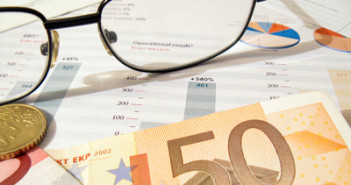After some sharp ups and downs late last week, EUR/USD has settled down to start the new trading week. The pair has crossed above the 1.30 line in Monday’s European session. In today’s releases, Eurozone Sentix Investor Confidence dropped. The sole US release is a speech by Fed Reserve head Bernard Bernanke at the Federal Reserve of Atlanta.
Here is a quick update on the technical situation, indicators, and market sentiment that moves euro/dollar.
EUR/USD Technical
- Asian session: Euro/dollar was quiet, consolidating at 1.2991. The pair has crossed above 1.30 in the European session.
- Current range: 1.30 to 1.3050.
Further levels in both directions:Â Â
<img alt=â€EUR USD Daily Forecast April 5png†src=â€https://forexcrunch-wpengine.netdna-ssl.com/wp-content/uploads/2013/04/EUR-USD-Daily-Forecast-April-5png-350×196.png†width=â€350″ height=â€196″ />
<img alt=â€EUR USD Daily Forecast April 4png†src=â€https://forexcrunch-wpengine.netdna-ssl.com/wp-content/uploads/2013/04/EUR-USD-Daily-Forecast-April-4png-350×196.png†width=â€350″ height=â€196″ />
<img alt=â€EUR USD Daily Forecast April 3png†src=â€https://forexcrunch-wpengine.netdna-ssl.com/wp-content/uploads/2013/04/EUR-USD-Daily-Forecast-April-3png-350×196.png†width=â€350″ height=â€196″ />
<img alt=â€EUR USD Daily Forecast April 2png†src=â€https://forexcrunch-wpengine.netdna-ssl.com/wp-content/uploads/2013/04/EUR-USD-Daily-Forecast-April-2png-350×196.png†width=â€350″ height=â€196″ />
<img alt=â€EUR USD Technical View for currency trading April 1 2013″ src=â€https://forexcrunch-wpengine.netdna-ssl.com/wp-content/uploads/2013/04/EUR-USD-Technical-View-for-currency-trading-April-1-2013-350×186.png†width=â€350″ height=â€186″ />
- Below: 1.30, 1.2960, 1.2880, 1.2805, 1.2750, 1.2660, 1.2624Â and 1.2587.
- Above:Â 1.3050, 1.31, 1.3130, 1.3170, 1.3290, 1.3350 and 1.34.
- 1.3050 is providing resistance.
- There is support at the round number of 1.30. 1.2960 is stronger.
Euro testing 1.30 level – click on the graph to enlarge.
EUR/USD Fundamentals
- 8:30Â Eurozone Sentix Investor Confidence. Exp. -12.6 points. Actual -17.3 points.
- 10:00 German Industrial Production. Exp. 0.4%.
- 11:15 US Fed Chairman Bernard Bernanke Speaks.
For more events and lines, see the EUR/USD
EUR/USD Sentiment
- Euro tumbles, then recovers after ECB: The euro went on a wild ride on Thursday, following the ECB policy meeting. As expected, the ECB held the benchmark interest rate at 0.75%. As in the case of recent policy meetings, the market-moving event was the follow-up press conference with Mario Draghi. The ECB head hinted at a rate cut in May or June, and this sent the euro plunging. Draghi did not offer his usual optimistic view that the Eurozone economy would recover in the latter half of 2013. This time, he was much more cautious, stating that the ECB was “monitoring very closely†the deterioration in the economy. Draghi did reassure the markets that the Cyprus bailout was a unique situation, and that taxing depositors would not become normal procedure. The markets gave Draghi a thumbs up, as the euro shot higher, closing the action-packed trading day above the 1.29 line.
- Euro posts strong gains against US dollar: Despite the Cyprus bailout crisis and a tacit admission by Mario Draghi that the Eurozone economy is in trouble, the euro managed to rally against the US dollar, gaining close to two cents over the week. The euro was bolstered by continuing weak US numbers, and posted strong gains late last week following poor US employment data. However, the euro is unlikely to continue climbing if the Eurozone economy continues to deteriorate.
- Cyprus deposits face huge hit: The bailout agreement may have been signed between Cyprus and its international creditors, but the drama and uncertainty surrounding the rescue package continue. Strict capital controls remain in place in Cyprus, as the government remains fearful of a run on the banks. Meanwhile, authorities revealed the plan for taxing around 60% of the money on big accounts (above 100K) in the Bank of Cyprus. This steep tax is expected to have a strong negative impact on the country’s business sector, and the government has admitted that the country is in recession. In order to help the slumping economy, Cyprus plans to lift a ban on casinos and provide tax exemptions on business profits that are reinvested on the island. President Nicos Anastasiades has acknowledged that the bailout agreement is painful for Cypriots, but said that failure to reach a deal would have resulted in the collapse of the banking sector and could have led to an exit from the Eurozone. The government continues to struggle with the crisis, and Cyprus finance minister Michael Sarris resigned last week. Sarris said he had done so in order to facilitate a formal investigation, which will examine the events leading up to the 10 billion euro bailout.
- Eurozone numbers raise concerns: There has been talk of the Eurozone economy improving sometime in 2013, but so far this year, the economy has not shown much in the way of a recovery. This was underscored by disappointing data last week. PMI numbers out of Spain, Italy and the Eurozone point to continuing contraction in the services and manufacturing sectors, with consistent readings below the 50-point level. Meanwhile, the employment situation on the continent is a disaster, as the Unemployment Rate in the Eurozone edged up to a record high of 12.0%. The euro will likely lose more ground if the markets don’t see better numbers out of Europe.
- US numbers continue to falter: The US continues to churn out disappointing numbers, and every key release over the past two weeks has fallen below expectations. The data comes from across the economy – manufacturing, housing, consumer confidence and employment numbers have all missed their estimates. On Friday, Non-Farm Payrolls joined the parade of dismal readings, posting its lowest gain since last July. The key indicator added just 88 thousand jobs, way below the estimate of 198 thousand. The Unemployment Rate nudged lower to 7.6%, but this was only thanks to a sharp drop in the participation rate. Has the US recovery stalled? If this week’s numbers don’t improve, we could see some turbulence in the currency markets.



